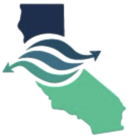Save the date for biennial Flood-MAR Network forum

Save the date for this fall’s Flood-Managed Aquifer Recharge (Flood-MAR) Network forum. This biennial event will be Nov. 7 and 8, in Sacramento. The final agenda has not been released, but it will focus on the development and implementation of Flood-MAR projects during the last five years.
|
New SGMA brochure being made available in English, Spanish
DWR has released a brochure that provides an overview of the elements in the Sustainable Groundwater Management Act (SGMA). In 2014, SGMA was passed to create a statewide framework that would provide long-term protection of groundwater resources. The brochure describes benefits of SGMA and includes DWR resources to help with SGMA compliance. A Spanish version of the brochure is available.
Webinar to provide review of groundwater sustainability plans

The Groundwater Exchange is hosting a webinar on Tuesday,
Aug. 15, to present information on a review of groundwater sustainability plans. This webinar will provide an overview of analysis done on the plans and will include information about how the plans may not be sufficient to protect groundwater for many users. There will be brief presentations, a live demonstration of an interactive visual data tool, and a question-and-answer session.
|
Drought strategies, program updates on CWC agenda
The next meeting of the California Water Commission (CWC) will be Wednesday, Aug. 16, in Sacramento. Commissioners will hear reports on the results of recent panel discussions and public workshops on drought strategies. The agenda includes updates on the Model Water Efficient Landscape Ordinance (MWELO) and the Water Storage Investment Program.
Nature-based grants being made available to California Tribes

The California Natural Resources Agency has announced a new grant program that is making $101 million available to help California Native American Tribes deal with the effects of climate change. The Tribal Nature-Based Solutions Grant Program will support Tribes to reacquire ancestral land, address impacts of climate change, and protect biodiversity. Among other things, the funding can be used to purchase land, train workforce, and build projects to protect culturally important natural resources.
|
Briefing will cover information on the basics on agrivoltaics
Information about a growing area of research into the water-energy-food nexus will be shared by the California Council on Science and Technology on Monday, Aug. 14. Agrivoltaics is the location of solar panels on agricultural lands that results in the production of agricultural products and electricity. The CCST briefing will discuss the recent expansion and benefits of agrivoltaics.
The story behind the removal of dams on the Kalmath River
The purpose and process of removing dams from the Klamath River is explained in a new article from the Water Education Foundation. The effort is the largest dam-removal project in U.S. history, tearing down four dams with the intention of returning the river to its more natural flow. The article covers the reasons the dams were built, the motivation for removing them, and the hope for the future of the Klamath River.
To subscribe to California Water Plan eNews, visit the DWR email subscription page and select the “California Water Plan eNews” option.
Subscribe to the Save Our Water newsletter.
|